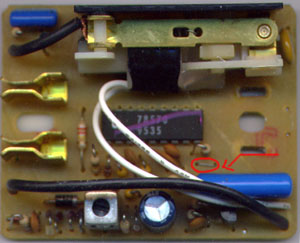Difference between revisions of "Local Control for Lamp And Appliance Modules"
| Line 34: | Line 34: | ||
[[Category:frequently asked questions]] | [[Category:frequently asked questions]] | ||
| + | What is correct the picture or the module number? I cut the jumper on the AM486 as shown in the picture but this made the lamp blink brighter. | ||
Revision as of 04:51, 27 March 2008
Questions
What is the local control feature on the Lamp and Appliance Modules?
Why does my Lamp or Appliance Module turn on immediately after being turned off?
Why does a low-wattage light connected to my Lamp or Appliance Module flicker after being turned off?
Why does the LED power light on my appliance or charger glow dimly or flicker after being turned off?
Why do I still measure some voltage moving through my module when it is off?
Answer
The local control feature allows you to turn on the Lamp or Appliance Module without the use of an X10 controller. To use this feature, turn the physical switch on the device being controlled to the OFF position, and then back to the ON position. The Lamp or Appliance Module detects the change and turns on. This is a handy feature when you are sitting next to a table lamp, but the remote is out of reach. Note: This feature will only turn the Module on. If you repeat the process--thinking that the Module will switch off--the Module will remain on. In order to turn off the Module, you will need a controller to send the off command via the house wiring.
Local Control Problems
There are two possible issues that relate to the local control feature.
Faint Blinking
Local control works by sending a tiny pulse of current out, just enough to tell if current can get through. It is possible for LED lights or other low-power lights to blink faintly because of this.
Will Not Stay Off
Local control senses the electrical resistance in the connected lamp or appliance. If it sees a change in resistance, the Module will turn on. Some devices (older fluorescent lamps do this often) have internal components that dissipate power for a couple of seconds after they are turned off. This "trailing charge" can make the Module turn back on right after it is turned off.
Disabling Local Control
It is possible to disable the local control feature of an Appliance Module by plugging a "cube tap" or cheap two-prong multi-outlet extension cord into the Module. This lets you plug two items into the same Module. Plug a 7 1/2 watt incandescent night light into one of the receptacles of the cube tap or extension cord and the appliance you want to control into the other. When the Module is on, the appliance and night light will be on. When the Module is off, the appliance and the night light will be off. Now, even if you operate the power switch on the appliance, the night light is always "in circuit" so the Appliance Module's local control circuit is disabled.
There is an unofficial, warranty-violating procedure that will permanently disable Local Control on an AM466 appliance module. You perform this procedure at your own risk. It requires a skinny Philips screwdriver and a pair of scissors or wire cutters.
- Disassemble the module
- Locate the small jumper close to the large blue capacitor (see picture)
- Snip the jumper
- Reassemble
 The picture you show is a AM486 module. The jumper on the AM466 is marked fuse.
The picture you show is a AM486 module. The jumper on the AM466 is marked fuse.
Related Articles
What is correct the picture or the module number? I cut the jumper on the AM486 as shown in the picture but this made the lamp blink brighter.